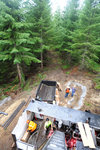


As interested parties wait anxiously for a decision from the Bureau of Land Management, details about the proposed mineral prospecting project near the Mount St. Helens National Volcanic Monument have proven tough to extract.
Ascot Resources, a Canadian company, has been seeking permission to drill core samples near Mount St. Helens since 2011, but lawsuits and environmental concerns have thus far kept them from breaking ground. In early February, the U.S. Forest Service announced it had signed off on a permit that would allow the company to drill 63 prospecting holes near Goat Mountain.
Now, the BLM must decide whether or not to grant permission for the project.
In the meantime, Gar Abbas, district ranger of the Cowlitz Valley Ranger District in the Gifford Pinchot National Forest, has faced plenty of criticism from opponents of the proposal who fear the project could lead to degradation of one of Washington’s wild places. Just as he did in his lengthy report, Abbas continues to firmly defend his decision to sign off on Ascot’s proposal.
“It’s not a tough decision because it’s a very simple project,” Abbas told The Chronicle. “The concerns that most people have for this project is that it somehow contributes to the possibility of a mine someday, and that’s not part of the consideration for me under the law that I am directed to follow.”
Abbas was adamant that his decision to sign off on the work permit is in no way indicative of his support for a full-fledged mining operation, but he declined to speculate on future proposals.
“If anything was to come of that down the road then we would have to do a new comprehensive analysis,” he said.
For their part, representatives at Ascot Resources, which is registered as Ascot USA for its operations in Washington, have remained coy about the company’s long term plans in the area.
“We are looking to continue our core sampling to do our study to determine the size and content of the mineral deposit,” said Mike McDonald, a representative of Ascot Resources. “What we intend to do is our prospecting and see how it lays out underground to come up with our method of extraction.”
When asked to identify possible methods of extraction, McDonald declined, noting that there are numerous options. He added that it is too early in the process to tell whether a mine would be suitable for the area near Goat Mountain, but he admitted, “That would be in the realm of conversation, yes.”
Like Ascot Resources, Abbas feels it is too early to predict what may happen if valuable minerals are discovered underground near Goat Mountain.
“They will definitely have the opportunity to continue to engage with us in the future,” said Abbas. “The hard part for me is that I can’t predict what another entity might choose to propose to us in the future. All I can say is that the Forest Service takes it very seriously to protect our resources out there.”
Many locals, politicians included, have harbored hope that mineral prospecting in the Gifford Pinchot National Forest would be a boon to a struggling East Lewis County economy, but Ascot Resources has dodged multiple attempts to find out just how many jobs the work could mean for locals.
“That’s kind of a hard one for me to answer right now,” said McDonald. “When we get that question a lot, at Ascot Resources our main focus is to drill for minerals.”
McDonald explained that Ascot Resources does not build roads or provide security for work sites, for example. Instead, they bring in their own trained drilling team and contract out the rest of the associated jobs.
“That’s what we’ve done in the past and we anticipate doing that into the future,” said McDonald.
Later, in an email, McDonald clarified, “Any positions that can be filled locally will be filled locally. We are committed to the local area and that is why we opened and have maintained an office there as we’ve worked through the permitting process.”
However, Abbas was more specific about the expected size of the proposed project slated for approximately 15 miles south of Randle.
“We looked at the economic impacts of that and they are fairly small,” said Abbas, who anticipates only about 12 people will be needed for the initial core sampling project. “It’s a very small outfit and a very small project.”
With Ascot bringing in its own drilling crew, that leaves few jobs available for local workers.
Lewis County Commissioner Gary Stamper, who has continuously backed the proposal, was hoping for more local jobs to help stoke community support for the project.
“This would be a big deal for these people,” Stamper told The Chronicle earlier this month. “Twenty jobs is a lot of jobs on that end of the county.”
Ultimately, the size and timing of the project will be determined by the BLM decision, said McDonald, who expects that decision will be announced in the coming weeks. If the BLM approves the project, then there would be a public comment period for at least a month before any work can be given a green light.
“It’s just kind of hard to put a real date on things until we get that decision from the BLM because once they deliver that decision we can get our permits back in order, and our drilling is kind of dependant on snow melt,” explained McDonald.
McDonald said that previous core sample drilling in the area was conducted during June of 2010, and Abbas has noted that the earliest possible date for breaking ground on the project would be the coming summer months.
Before drilling can be conducted, Abbas noted that the zig-zagging access road will need to be repaired. He said it is currently blocked by downed trees with holes in the road where culverts were removed. Abbas added that the culverts would be removed and the roads blocked again at the completion of any project, so any road work related to mineral prospecting will not result in increased public access. However, Abbas said that permit fees paid by Ascot Resources will help with maintenance in other areas of the Gifford Pinchot National Forest.
“Any commercial activity that they do within the Gifford Pinchot National Forest with a commercial-size vehicle they will have do to through a permit system which goes toward maintenance on our roads,” said Abbas. “Their main access route is the 26 Road. Currently it has a couple of large washouts that we are planning on fixing and we are working toward that. I guess there is a small potential that they may want to contribute to fixing them, but I wouldn’t bet on it.”
McDonald said that Ascot Resources is familiar with the obstacle presented by conducting mining operations in such a remote and environmentally sensitive area.
“It is common for exploration and mining to occur near environmentally sensitive areas. Wherever we operate, we work with government agencies and stakeholders to ensure we protect the environment,” said McDonald, who downplayed any negative impacts associated with the company’s aspirations.
Likewise, Abbas says that the potential environmental impact from the prospecting project is expected to be negligible, and visitors to the forest should experience minimal impact.
“In general the effects to water quality and quantity are nill. We don’t see any effects on quantity or quality in the Green River, so that’s a nonstarter,” said Abbas.
“There's going to be some interruptions to recreation at times. They’re going to have to drive around them and they may hear them working in the background, but it’s a short window of activity. In general it’s low impact and transient.”
In spite of those interruptions to access and the tranquility of the public forest lands just outside the Mount St. Helens National Volcanic Monument, and within the range of the Green River Valley, which is designated as a Wild and Scenic river as well as a wild steelhead gene bank, Abbas contends that mineral prospecting fits with the designated uses for the forest.
“This is where you get into law policy regulation. The way the laws and policies are written for the forest is that we accommodate as many uses as we can without a significant impact. And the law specifically states that we will allow for mineral exploration,” explained Abbas. “We are benefitting that section of the public that wants to see the forest used for multiple uses.”
McDonald insisted that Ascot Resources has received a good deal of support locally, and he extolled the various uses for minerals beyond hoarding gold and silver.
“We’ve experienced strong local support over the last few years. Many supporters want to know if there is a significant mineral deposit on the site, some support any economic activity in the state, and others strongly (support) extracting important natural resources such as copper that are essential for green energy applications and modern technology,” said McDonald.
He named copper, molybdenum, gold and silver among the minerals that Ascot Resources would be looking for.
“Copper is used in everything in many modern products. Copper is essential for the green economy. Sand is used in wind turbines and to (make the Toyota) Prius, which require three times the copper of traditional cars,” explained McDonald. “Molybdenum is used as a alloying agent in steel and is used widely in airplane parts. Beyond silver and gold uses in jewelry they also have many applications in technology.”
What’s more, McDonald says patriotic Washingtonians shouldn’t be worried about the consequences of selling off mining rights for natural resources to a foreign company.
“It’s common to have U.S. companies operate in Canada and vice versa as we are strong economic partners and allies. Many mining companies operating in the United States are in fact Canadian based and registered on the Vancover (sic) Exchange which is one of the major international mining hubs,” reasoned McDonald.
He added that questions about how and where minerals may be shipped are “premature and would be reviewed as part of permitting process if a mine was ever planned.”